Create the perfect design portfolio: 30 pro tips
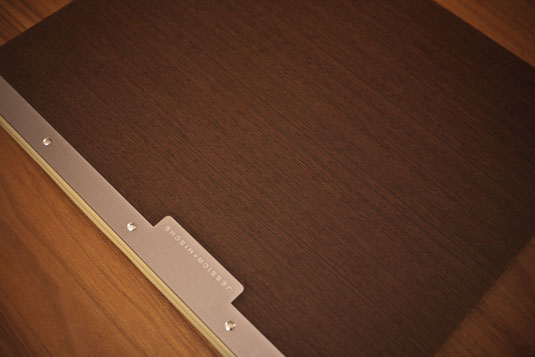 |
| Create the perfect design portfolio: 30 pro tips |
how to create a design portfolio - By Craig Stewart
Whether physical or online, your portfolio is your career calling card. Here's how to get it right and win that dream job.
How much time do you spend improving your portfolio? Be honest - does it showcase your best stuff? Whether your design portfolio is physical or digital, read on to discover how to create the perfect portfolio today!
There's nothing more important to your career than presenting your best work in an attractive, professional and accessible way. So for this article we've spoken to leading designers, illustrators and creatives and pulled together a selection of great tips and advice for dusting off a tired design portfolio and making it the very best it can be for that design job that you've discovered on the Creative Bloq jobs board.
We've divided the tips into physical and online portfolios - let's start with the physical...
Physical portfolios
There's no rule to say you can't have different design portfolios for different jobs
Physical design portfolios are one-off paper creations, so they can be tailored to the job you are applying for. Other than time constraints, there's no reason you can't create multiple design portfolios tailored to different jobs or different types of company.
01. Include a breadth of work
How many examples should a design portfolio include? It's a tricky question, but you should aim to fill at least 20 pages of a physical folio, and at least 30 examples for an online space. You need to be able to show a healthy breadth of work together with a range of applications, so even if you select several examples from a single project you should make sure you treat image individually.
02. Include appropriate examples

Only include design portfolio examples for a full-time position that are appropriate to the role. A creative director position, for instance, won't entail much artworking - if any at all - so work that demonstrates tracking and kerning ability isn't relevant.
03. Provide context to your work
Illustrators and designers aren't just employed for their style but also for the clarity with which they interpret a creative brief. So if you include examples of your artwork without providing context, it's impossible to judge. Make sure you use annotations and notes to talk about how and why the work was created. Make it clear what the brief asked for in each design portfolio example you include, and then demonstrate how you successfully accomplished it.
04. Non-client work is acceptable

That doesn't mean, of course, that your design portfolio must only include client work. Self-initiated projects are certainly acceptable in full-time applications, and recommended for freelance work - especially for illustrators.
05. Give it a regular spring clean
Resist the temptation to bulk out your design portfolio with old or irrelevant examples of your work by having a thorough and ruthless clear out. And don't leave this until it's unavoidable. Design portfolios need constant attention - you never know when you might be called on to present to Saatchi's creative directors...
06. Include case studies
Don't think of your design portfolio simply as a collection of your art and design work. Recommendations and real-life case studies go a long way in showing how professionally capable you are. Ask a previous client or employer for a recommendation, and write up a short case study to accompany a project.
07. Take a step back
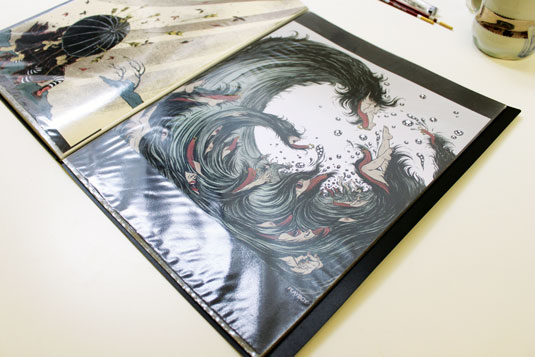
Take a step back and try to look at your design portfolio through another's eyes. Experienced employers, project managers and agents know how to match up a CV to a design portfolio and gauge your character strengths and weaknesses, warts and all. So think critically about what your design portfolio says about you. Is it too serious? Too flippant? Strike a balance that you believe shows off your qualities.
08. Demonstrate all-round experience
Are you only good at illustration or editorial layout? Of course you're not: you're also a solid communicator who understands budgets and deadlines, as well as the importance of meetings and updates. These are all professional skills. Make sure your design portfolio clearly showcases that you posses these, even if you just simply list them in your accompanying notes.
09. Sell yourself
Think about what other creative talents you might have as well. For instance, if you're a handy photographer or accomplished with coding, why not include examples of your shots or web designs? They're all more strings to your creative bow.
10. Index your design portfolio
What do you do when you find a particularly interesting website, magazine spread or book chapter? You bookmark it, dog ear it or jot down the page number somewhere. Those viewing your design portfolio - by whatever medium - will do the same, so make it easy by including page numbers and clear project titles for each portfolio example.
Online porfolios
These days if you’re looking for work as a designer, whether a full-time job or a freelance gig, you're probably going to need an online design portfolio as well as a physical one.
It doesn’t matter how many glowing references you have or how impressive your work history, no one’s going to be interested unless they can see what you can do. And a design portfolio website is the easiest and quickest way to showcase your work; these days, in fact, it’s expected. But while many designers have their own design portfolio website, not all of them are fit for purpose. Even where the work featured is superlative, the site itself is attracting a mere trickle of traffic and generating few, if any, enquiries.
An online design portfolio is your creative shop window. It's always on - 24 hours a day, 7 days a week, 365 days a year - and it's always working to showcase who you are and what you can do.
But is this silent sales machine working hard enough? Have you set it up correctly? Are you showing off your BEST stuff? If you think that your design portfolio website is underperforming, don't wait around. Now is the time to tackle it...
11. Choose your platform

Squarespace is a good platform for creating a bespoke design portfolio site
How do you physically set up an online design portfolio? The good news is that you have a number of options.
If you're technically-minded, get yourself a personalised domain name, invest in some hosting and set up a WordPress website. WordPress is easy to use, extraordinarily flexible and enjoys massive community support. In fact, we'd recommend you give it a try, even if you don't think of yourself as 'technical'.
If you really don't have time, though, you can always pay somebody to do all of the above. Alternatively, consider using a done-for-you web platform. You could set up a hosted blog at Wordpress.com in a few minutes, for example. Or create something a little more advanced using the drag-and-drop loveliness of Squarespace.
Design portfolio Big Black Bag
Big Black Bag is a dedicated platform for creating bespoke design portfolios
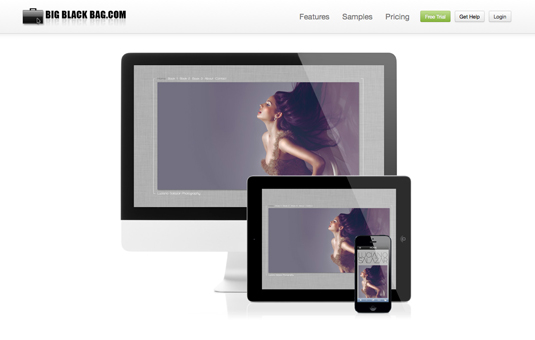
Finally, you could instead use a dedicated design portfolio platform like Behance, Carbonmade, Portfoliobox or Big Black Bag. In other words, there are no shortage of options, so you have no excuse for building yourself an online design portfolio!
12. Consider your aims
Before you rush in to build your design portfolio site, think about why you're doing this. Many designers think having an online design design portfolio is an end in itself - but if you don't know what you're trying to achieve with your design portfolio, you won't know whether it's succeeding.
"Think about the goal of your design portfolio," advises Seattle-based illustrator Jared Nickerson. "In the beginning I just wanted constructive feedback, so would only post one image of the core work. Nowadays I try to showcase different usages of a design or placement on products, and give some insights into the process."
13. Be selective

Jeff Knowles' design portfolio shows only one piece at a time - giving each the ability to shine
As with a physical design portfolio, don't make the mistake of trying to show off too much of your work. Potential clients don't need to see EVERYTHING. Instead, be more selective. Focus on your best stuff and the work you've done for high-profile clients.
When showing off your work, consider the sort of briefs that you'd like to tackle in the future. Show the sort of work that you want to do more of and that illustrates the full set of your skills and abilities.
"The work that you choose to showcase should be the type of work that you want to be hired to produce," reasons New York-based designer and type artist Sasha Prood. "Be selective, and only show the projects that you can really stand behind. A great way to develop your design portfolio further is through self-initiated projects."
14. Curate work carefully

The diverse work of Tim Lahan is curated perfect on www.trademark-trademark.com
There's another aspect to the artwork you choose to put up - how well it works together. "Curate the work you put up carefully," adds London-based illustrator Malika Favre. "Online folios need the same rhythm as printed ones: you need to tell a story, and order your projects so that they feel fluid and complement each other. If it means that an old project has to be removed to fit the new story, so be it."
15. Show, don't just tell
The website you build can say a lot about you in the first few seconds if you design it properly. In other words, you show people what you can do before you even get around to telling them.
So if you're a web designer, for example, have a beautiful, quick-to-load online design portfolio that showcases your coding and design talents. If you're an illustrator, make your artwork part of the design. If you're a graphic designer, impress the hell out of your visitors with great typography, a custom logo and easy-on-the-eye layouts.
These subtle cues can often make or break any connection with your web visitors. We recently found a marketing agency who built mobile-optimised websites, yet their own site wasn't optimised for mobile...
16. Keep adding new work
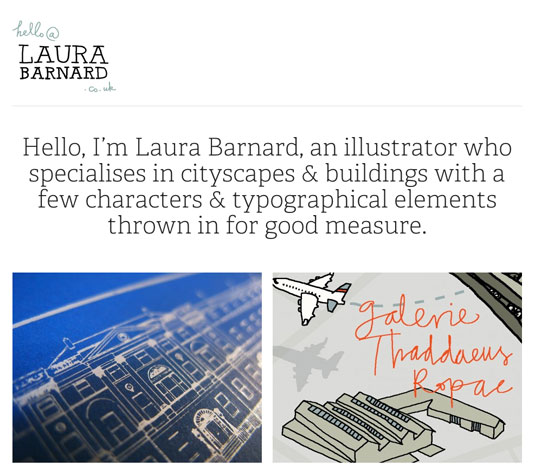
Laura Barnard adds new projects to her online design portfolio regularly, keeping it fresh
"By far the most important thing for me is making it easy to put new work up there," reflects illustrator Laura Barnard, who uses the Squarespace platform. "You could have the fanciest site in the world, but if it was last updated five years ago it looks a bit lazy."
Mexico-based designer and illustrator Christopher Mooij agrees that regular updates are crucial - and not just those showing finished work: "Let people know what you're working on, or what you've done over the past few weeks," he says. "Obviously those posts shouldn't be filled with your personal diary: make it smart."
17. Streamline updates
The advice in the previous point is easy to give, not so easy to carry out in practice. Speak to some of the world's leading designers and you'll hear them bemoan the fact that their online portfolio needs work but they're too busy.
"Completed projects can start ganging up, and it ends up being a project in itself to get your portfolio sorted," says Jeff Knowles. His solution is to make a versatile template, and a concise system for naming and describing your projects: "At the end of each one, simply select your best images and populate the templates."
18. Photograph printed work

The online portfolio of Sasha Prood makes great use of photography to showcase printed work
"One of the biggest challenges is figuring out how to display printed material on screen," points out New York-based designer Derek Chan. "While digital versions of your work will help, photography is definitely the best way to show these off. It's all about the context, and showing your designs as they were intended to be seen."
"If you do photograph your work, invest time and resources into making the images as good as possible," adds Emmi Salonen, creative director at Studio EMMI. "Just as spelling mistakes do, images with no contrast, bad focus and so on take attention away from your work, and make the viewer focus on how the presentation could be improved."
19. Label your portfolio examples
It's often a good idea to clearly label the work in your online portfolio. This will allow clients to reference individual designs or artwork when they speak to you.
20. Give an insight into HOW you worked
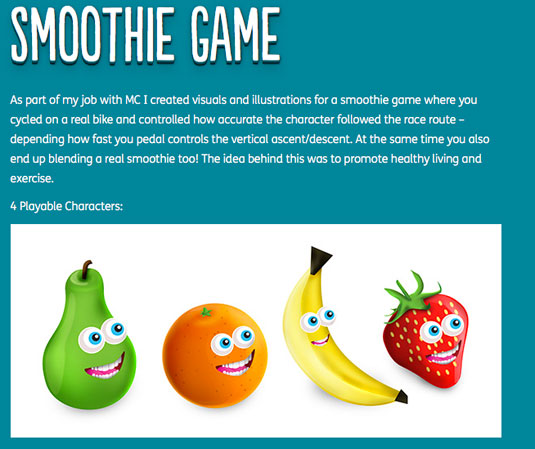
Olly Gibbs' portfolio site at www.ollygibbs.com gives clear explanations of his work
Rather than just showing the finished design, artwork, logo or illustration, give an insight into how you did it. Give a short description of the brief and how you interpreted it to fulfil the wishes of the client.
21. Avoid long intros
You've only got a few seconds to make an impression when somebody visits your portfolio website. Don't waste it with a slow-to-load flash intro or a home page that doesn't immediately showcase your work and why it's different to all the other designers/artists out there.
If you work in Flash or animation, create something that showcases what you can do and make it part of your portfolio. If you don't then why would you need a long intro in the first place?
22. Consider making it a PDF

Jonathan Edwards' portfolio is available as a downloadable PDF
To give potential clients a different way to browse through your work, consider offering your work as a downloadable PDF. Computer Arts has a great tutorial on how to do this here.
23. Encourage action
The best websites are structured in such a way that they funnel visitors to certain pages and invite them to take some sort of action. This might be to fill in a contact form or send you an email. It might be to buy some of your work. Think about whether your current portfolio answers the main questions that your clients will be asking. Questions such as:
Who is this person?
Where are they?
What have they done before?
Are there examples of their work that I can view?
Who else have they worked for?
How do I get in contact with them?
What do they charge?
Make sure that your online portfolio is easy to navigate and that there are clear goals for each page.
24. Make it simple to navigate
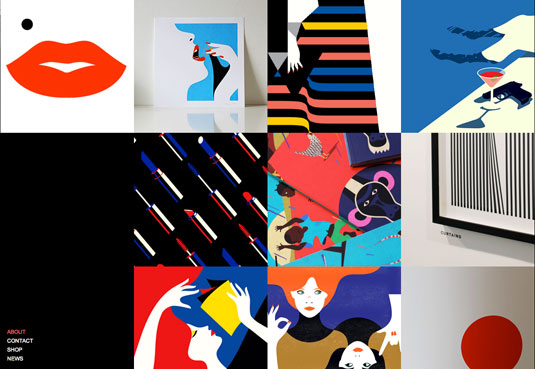
No one could fail to find what they're looking for on Malik Favre's portfolio site
People's attention spans are short. Your online portfolio needs to be quick and easy to browse. This is not as straightforward as it sounds. You need to:
Keep the design simple, accessible, convenient and classy.
Use an eye-catching logo or motif to make your site stand out
Try adding a tagline that succinctly explains what you do
Display prominent contact details so visitors are in no doubt as to how they can email you, follow you on Twitter or connect on Facebook.
Make it clear you want people to hire you (don't assume they can read your mind. Sometimes you can't beat a good 'Hire me' button.
25. Publish testimonials
If shopping on Amazon has taught us anything it's that people love to know what other people think. Getting testimonials from satisfied clients is a great way to show some 'proof' that you can deliver on what your portfolio promises.
26. Cater to diverse tastes
"One of my best-selling prints is quite frankly one of my least favourite pictures," admits Stan Chow, who sells his work online through Big Cartel. "Potential clients and buyers look for different things, and sometimes you have to put up images you don't like so much, because the chances are that somebody else will."
27. Promote your portfolio

There's no point in having a great portfolio site if no one is visiting. Be active on Facebook, Twitter and Google+; deploy portfolio pieces to Behance, Flickr, Dribbble (see below) and deviantART. Film yourself working and put the video on YouTube. Aggregate artwork into a slideshow and share it on Slideshare. Put together a PDF brochure and upload it to Scribd. The more places you share your content, the more you'll drive people towards you and your portfolio website.
28. Add a blog
For Jonathan Edwards, a regularly updated blog keeps people coming back: "Set yourself a task, like updating your blog every day for 100 days," he suggests. "It may seem a pain to have to find something new to post every day, but in the long run you'll thank yourself. You'll have 100 new drawings, for a start."
29. Update your blog
Google loves a well-structured, regularly updated website that's stuffed with great content - and the easiest way to provide fresh content is to keep your blog updated. You can write about the projects you've worked on, share your thoughts about art and design trends and reveal your favourite tools.
In general, the things that make visitors happy are the things that make Google happy. However, striking a balance is always important - in other words...
30. Don't get hung up on SEO
It's easy to get obsessed by Search Engine Optimisation (SEO), the art/science of trying to get your site high in the Google rankings. In fact, you can spend too much time worrying about keywords when you should be concentrating on website content.
Online portfolio sites typically feature fewer words so traditional SEO is often ineffective. You will probably get better results by promoting yourself (and your website) through other web channels - see point 17
With the information we provide about how to create a design portfolio
, We hope you can be helped and hopefully set a precedent with you . Or also you can see our other references are also others which are not less good about Fashion Sketching 101: How to Draw Fashion Figures
, So and we thank you for visiting.
open tutorial sew : http://www.creativebloq.com/create-perfect-design-portfolio-111153


0 komentar:
Post a Comment